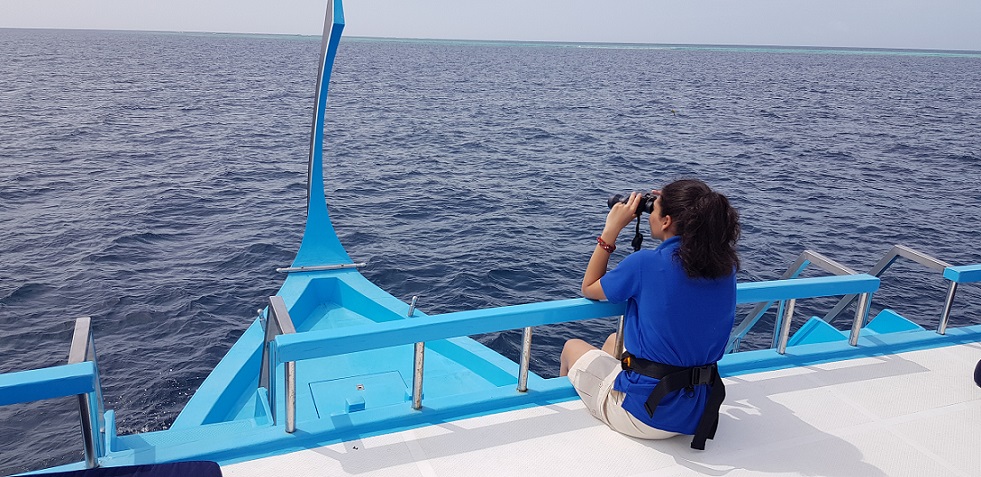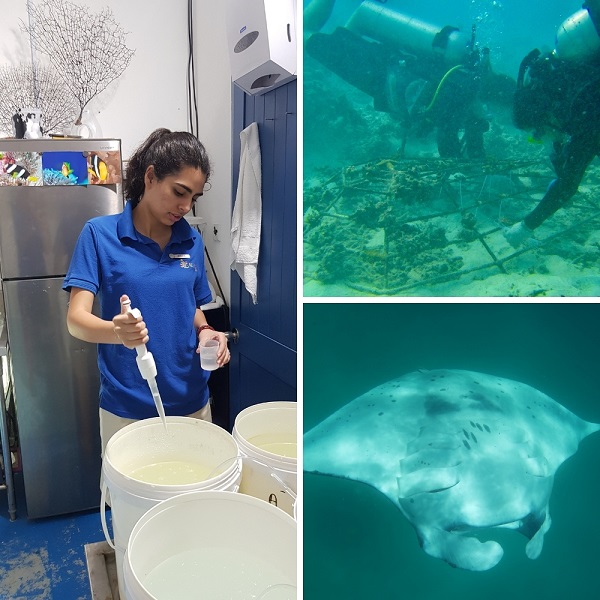An unforgettable marine conservation internship experience!

Hi, I am Miraya Vadra. As an 18-year-old girl, I have a deep love for animals, which developed while growing up in a house filled with various animals and also with the exploration of jungles of India. Furthermore, as I travelled with my family to coastal regions, I started to dive underwater and was exposed to a new world. The more time I spent underwater, the more I fell in love with the oceans. I used every excuse I could to come back to the sound of the crashing waves. At 10 years old, I became a PADI certified Junior Open Water diver, and from then on, my interest in the underwater world grew even more.
This story is about my marine conservation internship in the Maldives. I was training for my PADI Advanced Open Water Course at the Four Seasons Hotel – Laanda Giruvaruduring. After witnessing the beautiful reefs of Maldives, I acquired a keen interest in marine life feeling a responsibility towards its conservation. The thirst for learning about marine life, the science that takes place underwater and the intention for its preservation kept growing. One fine day, I met the marine conservation team at the Four Seasons called ‘The Marine Savers’. They had been doing incredible work around the island like coral propagation & reef-building, rescue & rehabilitation of injured sea turtles, sea turtle nest protection and hatchling rehabilitation.
They are also one of the centres associated with ‘The Manta Trust‘. After speaking to the conservation team, understanding their work, I wanted to get some hands-on experience. Unfortunately, their 3-month internship program required one to have a postgraduate degree. I wrote them emails illustrating my deep interest in learning about marine biology and showed them research that I had previously conducted. I was lucky to get an opportunity to intern with them for 2 weeks.

During my marine conservation internship, I was to assist in coral restoration, turtle rehabilitation, and Manta identification. I was incredibly excited to learn and couldn’t wait to start. Let me tell you a little bit about each of the program that I assisted during my marine conservation internship.
The Marine Conservation Internship Projects I Assisted With –
Coral Restoration Project
Corals are invertebrate animals that exhibit a wide range of colours, shapes and sizes. Most corals live in a group of hundreds or thousands of genetically identical polyps, individual coral animals, and together they form ‘colonies’. There are hard and soft corals in the world, depending on the environment they live in. Different species and varieties of animals use these corals as habitats. The actions of humans have a significant impact on coral survival. There are many ways corals are threatened. More commonly, damage or destruction from coastal development, destructive fishing practices, boat anchors and groundings, and recreational misuse (touching or removing corals). Another major cause of coral death is coral bleaching, which occurs due to global warming as corals are extremely temperature-sensitive.
Coral restoration is crucial as they are home to a large number of animals (approximately 25 percent of the marine life depend on corals for their survival), they also act as a protective barrier for coastal communities and fuel the recreational & tourism industry. Corals also absorb carbon dioxide and do the work of trees inside the oceans.
While assisting the marine savers team in the coral restoration project, I created an artificial reef structure onto which pieces of hard coral were attached. We covered the base of the frame with sand, to camouflage it with the bottom of the ocean. My job also involved assisting the team in sinking the structure and monitoring of previously dropped structures. During the monitoring, all the broken coral fragments that we found would be attached to these structures.
Sea Turtle Rehabilitation Project
I also assisted in the rehabilitation of sea turtles project. The project involved rehabilitation of the sea turtles that had been injured by human activities (trapped in fishnets, pollutants in the ocean, or hit by the propeller of a boat). I learned how to feed and also track sea turtles living in the wild using photo identification. The identification involved taking facial profile photographs and using the unique scale patterns on their faces to form a code with a unique three-digit sequence representing columns of scales moving from closest to the eye to furthest from the eye. I also witnessed an operation on a turtle who had an infection in her liver. The experience was simply mind-bending.
Manta Identification project
The third project in my marine conservation internship was the manta identification program. The Manta Trust is a registered charity that coordinates global research and conservation efforts around manta rays, their relatives, and their habitats. One of their primary activity is tracking manta rays around the globe to maintain a database that keeps track of how many manta rays live in a specific area, their migration & reproduction patterns and such other information. The Marine Savers is also a Manta Trust centre, and with them, I got the opportunity to track manta rays too.
I accompanied experts who spent 8–9 hours on boats during the manta season (May to October on the eastern side of the Maldives), trying to spot manta rays. There are feeding zones where a large number of manta rays migrate to find food. Once a manta ray is spotted, we put on our snorkelling gear and jump into the blue with cameras in hand. We aim to take pictures of the bellies of the manta rays. Manta rays have black spots on their bellies that give them their own identities like fingerprints for humans (there are also white patterns on their blacktops that differentiate species). These pictures are then sorted and added to a manta ray database where each manta ray is given a name, and the areas where they were seen are recorded.
The marine conservation internship was a great learning experience for a beginner who wanted to pursue marine biology. I enjoyed working towards the conservation of the marine ecosystem. The experience from the Maldives stimulated me to work in the conservation of the coasts of India, and I am now thrilled to be using my experiences and past knowledge to be a part of Kuddle Life Foundation.
Marine conservation internships are a great way to get hands-on experience with the conservation of marine ecosystems. There is an urgent need for marine conservation and enthusiasts in a country like India, as it is one of the most forsaken areas for conservation. There are many good organisations in India working hard to preserve our beautiful oceans and the life that depends on it. Organisations like Reef Watch India, Dakshin and Kuddle Life Foundation are striving hard to conserve the oceans and streamline marine conservation into the community.

About Miraya Vadra
Miraya, born in Delhi, and recently graduated from the Shri Ram school. She has always had a love for animals and the different creatures of the world. She started scuba diving at nine years of age and discovered the fascinating world of the oceans. Since then, she formed an incredibly deep bond with marine life and their environments.

How to get engage with internships?
Hello, We will soon be publishing a blog on “a career in marine conservation” Keep following this space to stay updated. You could also follow us on social media and sign up to our newsletter to get regular updates. Meanwhile, to talk to us, you can also write to us at [email protected].